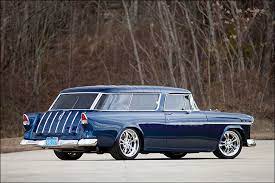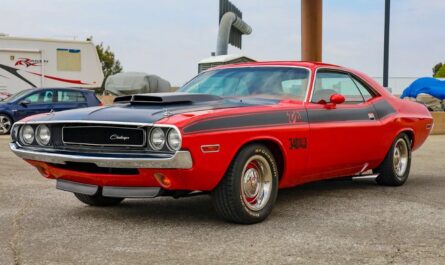The 1955 Chevrolet Nomad holds a special place in the hearts of car enthusiasts and collectors alike. As an iconic model from the golden era of American automotive history, the Nomad embodies timeless design, exceptional craftsmanship, and a true sense of adventure. In this article, we delve into the rich history of the 1955 Chevrolet Nomad, exploring its unique features, enduring popularity, and why it continues to capture the imagination of automotive enthusiasts around the world.

The Birth of a Legend
The 1955 Chevrolet Nomad was introduced as a stylish, two-door station wagon, combining the utility of a family car with the allure of a sports car. Its eye-catching design featured sweeping curves, elegant lines, and a distinct chrome trim, making it an instant head-turner. The Nomad was designed to stand out from the crowd, and it certainly succeeded in doing so.
Design and Features
Exterior Design: The Nomad boasted a sleek and aerodynamic body, characterized by its wraparound windshield, sculpted fenders, and distinctive “bel-air” trim. It exuded an air of sophistication and elegance that was unmatched by its contemporaries.
Interior Comfort: Step inside the Nomad, and you’ll find a spacious cabin adorned with luxurious materials and thoughtful details. From the plush seating to the tasteful dashboard layout, every aspect of the interior was designed with both style and comfort in mind.
Performance: Under the hood, the Nomad was equipped with a range of powerful engine options, including the legendary small-block V8. This enabled the Nomad to deliver impressive performance and a thrilling driving experience.

Enduring Popularity
Even after several decades, the 1955 Chevrolet Nomad remains an icon of automotive design and engineering. Its timeless appeal continues to resonate with enthusiasts, and it has become a sought-after collector’s item. Here are a few reasons why the Nomad has stood the test of time:
Unique Design: The Nomad’s distinctive design, blending elements of a sports car and a station wagon, sets it apart from other vehicles of its era. Its classic lines and elegant proportions make it a true work of art on wheels.
Cultural Significance: The Nomad’s association with the 1950s and the rise of American car culture adds to its allure. It represents an era of optimism, innovation, and the pursuit of the open road.
Limited Production: Chevrolet produced the Nomad in limited numbers, making it a rare find today. The exclusivity and scarcity of these vehicles contribute to their desirability among collectors and enthusiasts.

Frequently Asked Questions
Q: How many 1955 Chevrolet Nomads were produced?
A: Approximately 8,386 Nomads were produced in 1955.
Q: What are some notable features of the 1955 Chevrolet Nomad?
A: Notable features include the wraparound windshield, sculpted fenders, “bel-air” trim, spacious interior, and powerful engine options.
Q: Is the 1955 Chevrolet Nomad a good investment for collectors?
A: Yes, the Nomad has proven to be a solid investment, with prices appreciating over the years. Its rarity and timeless appeal contribute to its value.
Q: Were there any significant design changes in subsequent model years?
A: Yes, subsequent model years saw design changes, including revisions to the front grille, taillights, and overall styling. However, the 1955 model year remains the most iconic.
Q: Are there any modern cars inspired by the 1955 Chevrolet Nomad?
A: While no direct replicas exist, some modern cars draw inspiration from the Nomad’s design, paying homage to its timeless aesthetic.
Conclusion
The 1955 Chevrolet Nomad holds a special place in automotive history, representing an era of style, innovation, and adventure. Its unique design, powerful performance, and enduring popularity make it a true icon of American automotive culture. Whether you’re a collector, an enthusiast, or simply appreciate automotive craftsmanship, the Nomad is a timeless classic that continues to captivate hearts and minds.



